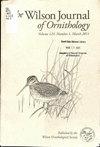Use of nest boxes, reproductive success, and sex ratio in two screech-owls in the Peloncillo Mountains of southeastern Arizona
IF 0.5
4区 生物学
Q4 ORNITHOLOGY
引用次数: 1
Abstract
ABSTRACT From 2015 to 2022, I studied nest box use, sex ratios, reproductive success, and morphometrics of the Western Screech-Owl (Megascops kennicottii) and Whiskered Screech-Owl (M. trichopsis) in southeastern Arizona. The Whiskered Screech-Owl in particular is at the extreme northern end of its distribution in the southwestern United States, with past research suggesting that it does not readily use nest boxes. Both screech-owls occurred in the study area in unknown densities but nest box use was higher with the Whiskered Screech-Owl. The Whiskered Screech-Owl nestling sex ratio varied but averaged about equal, with the mean number of male to female nestlings per brood being 1.11M:1.22F. Nest success was high for both species. Recapture data suggest that juveniles disperse outside of the study area and adults maintain site fidelity. Fourteen adult Whiskered Screech-Owls and 23 nestlings along with 9 adult Western Screech-Owls and 7 nestlings were banded over the course of this study. RESUMEN (Spanish) Del 2015 al 2022, yo estudié el uso de cajas nido, proporción de sexo, éxito reproductivo y morfometría de tecolote Megascops kennicottii y de tecolote M. trichopsis en el sudeste de Arizona. El tecolote M. kennicottii en particular se encuentra al extremo norteño de su distribución en el sudoeste de los Estados Unidos, con estudios previos que sugieren que no utiliza las cajas-nido disponibles. Ambos tecolotes se encuentran en el área de estudio con densidades desconocidas pero el uso de las cajas-nido era superior en el caso del tecolote M. trichopsis. La proporción de sexos en el nido del tecolote M. trichopsis varió pero tuvo promedios más o menos iguales, con el número promedio de crías machos a hembras por nidada de 1.11 M: 1.22 H. El éxito del nido fue alto para ambas especies. Datos de recaptura sugieren que los juveniles de dispersan fuera del área de estudio y que los adultos mantienen la fidelidad al sitio. Durante este estudio, se anillaron catorce adultos y 23 polluelos de tecolote M. trichopsis, junto con 9 adultos y 7 polluelos de tecolote M. kennicottii. Palabras clave: anillado, caja-nido, morfometría, proporción de sexo, tecolote Megascops kennicottii, tecolote M. trichopsis.在亚利桑那州东南部的Peloncillo山脉,两只尖声猫头鹰的巢箱使用、繁殖成功率和性别比例
本文章由计算机程序翻译,如有差异,请以英文原文为准。
求助全文
约1分钟内获得全文
求助全文
来源期刊
CiteScore
0.90
自引率
0.00%
发文量
133
审稿时长
4-8 weeks
期刊介绍:
Aims & Scope
For more than a century, the Wilson Ornithological Society has published a scholarly journal with form and content readily accessible to both professional and amateur ornithologists. The Wilson Journal of Ornithology is a quarterly publication consisting of major articles based on original studies of birds and short communications that describe observations of particular interest. Each issue also includes reviews of new books on birds and related subjects, as well as ornithological news. Through an endowment from the late George Miksch Sutton, each issue of the Journal includes a full color frontispiece. Each current volume consists of approximately 500 pages. The principal focus of the Journal is the study of living birds, their behavior, ecology, adaptive physiology and conservation.
Although most articles originate from work conducted in the western hemisphere (a large portion of the research on Neotropical birds is published here), the geographic coverage of the journal is global. The Journal is internationally recognized as an important, major journal of ornithology. The Edwards Prize is given annually for the best major article published during the previous year.
The Wilson Journal of Ornithology was formerly named the Wilson Bulletin.

 求助内容:
求助内容: 应助结果提醒方式:
应助结果提醒方式:


